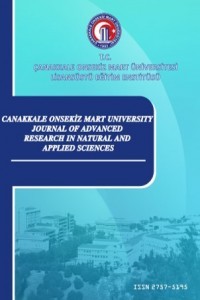Farklı pH ortamlarında hazırlanmış L-Askorbik Asit çözeltilerinin taşınabilir 1H NMR spektroskopisi ile pratik analizi
Askorbik asit, masaüstü NMR, pH, proton transferi
Benchtop 1H NMR spectroscopy as a practical tool for characterization of chemically ex-changing systems in Ascorbic acid
ascorbic acid, benchtop NMR, pH, proton transfer,
___
- Barskiy, D. A., Tayler, M. C. D., Marco-rius, I., Kurhanewicz, J., Vigneron, D. B., Cikrikci, S., … Pines, A. (2019). chemically exchanging systems. Nature Communications, (Moin Cc), 1–9. https://doi.org/10.1038/s41467-019-10787-9
- Bohndiek, S. E., Kettunen, M. I., Hu, D., Kennedy, B. W. C., Boren, J., Gallagher, F. A., & Brindle, K. M. (2011). Hyperpolarized [ 1- 13 C ] -Ascorbic and Dehydroascorbic Acid : Vitamin C as a Probe for Imaging Redox Status in Vivo. 11795–11801.
- Dopona, V. (2015). Comparative NMR Studies : Benchtop-NMR and 300 MHz NMR instrument. (February).
- Heerah, K., Waclawek, S., Konzuk, J., & Longstaffe, J. G. (2020). Benchtop 19 F NMR Spectroscopy as a Practical Tool for Testing of Remedial Technologies for the Degradation of Perfluorooctanoic Acid, a Persistent Organic Pollutant . Magnetic Resonance in Chemistry. https://doi.org/10.1002/mrc.5005
- J. Du, J. J. Cullen, G. R. B. (2013). Ascorbic acid: Chemistry, biology and the treatment of cancer. Biochim Biophys Acta., 1826(2), 443–457. https://doi.org/10.1016/j.bbcan.2012.06.003.Ascorbic
- Karakurt, I., Aydoğdu, A., Çıkrıkcı, S., Orozco, J., & Lin, L. (2020). Stereolithography (SLA) 3D printing of ascorbic acid loaded hydrogels: A controlled release study. International Journal of Pharmaceutics. https://doi.org/10.1016/j.ijpharm.2020.119428
- Keshari, K. R., Sai, V., Wang, Z. J., Vanbrocklin, H. F., Kurhanewicz, J., & Wilson, D. M. (2019). Hyperpolarized [1- 13 C]Dehydroascorbate MR Spectroscopy in a Murine Model of Prostate Cancer: Comparison with 18 F-FDG PET. 54(6), 922–929. https://doi.org/10.2967/jnumed.112.115402
- Ledbetter, M. P., Crawford, C. W., Pines, A., Wemmer, D. E., Knappe, S., Kitching, J., & Budker, D. (2009). Optical detection of NMR J-spectra at zero magnetic field. Journal of Magnetic Resonance, 199(1), 25–29. https://doi.org/10.1016/j.jmr.2009.03.008
- Ledbetter, Micah P., & Budker, D. (2013). Zero-field nuclear magnetic resonance. Physics Today, 66(4), 44–49. https://doi.org/10.1063/PT.3.1948
- Levitt, M. . (2000). Spin Dynamics: Basics of Nuclear Magnetic Resonance. In John Wiley & Sons Ltd. https://doi.org/10.1002/cmr.a.20130
- Park, K. J., Kim, M., Seok, S., Kim, Y. W., & Kim, D. H. (2015). Quantitative analysis of cyclic dimer fatty acid content in the dimerization product by proton NMR spectroscopy. Spectrochimica Acta - Part A: Molecular and Biomolecular Spectroscopy. https://doi.org/10.1016/j.saa.2015.04.099
- Paukstelis J.V., Mueller D.D., Seib P.A., L. D. W. (1982). N M R Spectroscopy of Ascorbic A c i d and Its Derivatives. In Advances in Chemistry (Vol. 200).
- Reid, R. S. (1989). The proton NMR spectrum of ascorbic acid: A relevant example of deceptively simple second-order behavior. Journal of Chemical Education, 66(4), 344. https://doi.org/10.1021/ed066p344
- Shapiro, Y. E. (2011). Structure and dynamics of hydrogels and organogels: An NMR spectroscopy approach. Progress in Polymer Science (Oxford), 36(9), 1184–1253. https://doi.org/10.1016/j.progpolymsci.2011.04.002
- Shchepin, R. V., Barskiy, D. A., Coffey, A. M., Theis, T., Shi, F., Warren, W. S., … Chekmenev, E. Y. (2016). 15 N Hyperpolarization of Imidazole- 15 N 2 for Magnetic Resonance pH Sensing via SABRE-SHEATH. ACS Sensors, 1(6), 640–644. https://doi.org/10.1021/acssensors.6b00231
- Singh, G., Mohanty, B. P., & Saini, G. S. S. (2016). Structure, spectra and antioxidant action of ascorbic acid studied by density functional theory, Raman spectroscopic and nuclear magnetic resonance techniques. Spectrochimica Acta - Part A: Molecular and Biomolecular Spectroscopy, 155, 61–74. https://doi.org/10.1016/j.saa.2015.11.005
- Yayın Aralığı: Yılda 4 Sayı
- Başlangıç: 2015
- Yayıncı: Çanakkale Onsekiz Mart Üniversitesi
Çizge Veri Tabanlarının Yapay Sinir Ağları İçin Kullanımı
Doğa Barış ÖZDEMİR, Ahmet Cumhur KINACI
Manisa İli Pamuk Üreticilerinin Bitki Koruma Uygulamaları
Tulay TURGUT GENC, Melih GÜNAY
Müge ENSARİ ÖZAY, Pelin GÜZEL, Emine CAN
Hayal AKYILDIRIM BEĞEN, Gazi GÖRÜR
Güven Aralıklarına Dayalı Bulanık Xbar ve S Kontrol Grafikleri
